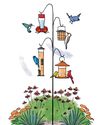Versuchen GOLD - Frei
Welcome, Caterpillars
Birds & Bloom
|August/September 2018
Grow host plants to help the next generation of butterflies and moths survive and thrive.

WORTH THE WAIT
Gas plants may take a few years to get established, but the showy result is so rewarding.

1 Gas plant
DICTAMNUS ALBUS, ZONES 3 TO 8
This novelty plant is a stunner. From May to June, white, pink or lilac flowers top vertical stems that reach 3 feet tall. The plant is low maintenance but needs full sun and well-draining soil. Wear gloves when handling gas plants to avoid any adverse skin reactions.
Why we love it: On windless summer nights, light the flammable oil from the gas plant’s old flowers or seedpods to emit a brief vapor.
Host to: giant swallowtail
2 Little bluestem
SCHIZACHYRIUM SCOPARIUM, ZONES 3 TO 9
A blue-stemmed beauty, this tufted warm-season grass provides wonderful winter interest. It’s also a resilient host plant that grows best on dry upland sites such as hilltops or ridges, though it is very adaptable to nearly all soil conditions.
Why we love it: The USDA says little bluestem is one of the best grasses for nesting and roosting birds, such as finches, sparrows and juncos.
Host to: common wood nymphs and skippers

3 Prairie blazing star
LIATRIS PYCNOSTACHYA, ZONES 3 TO 9
Diese Geschichte stammt aus der August/September 2018-Ausgabe von Birds & Bloom.
Abonnieren Sie Magzter GOLD, um auf Tausende kuratierter Premium-Geschichten und über 9.000 Zeitschriften und Zeitungen zuzugreifen.
Sie sind bereits Abonnent? Anmelden
WEITERE GESCHICHTEN VON Birds & Bloom

Birds & Blooms
Better Off with Bats
Rethink the unsung heroes of the night and why you should support them
2 mins
October / November 2025

Birds & Blooms
Late Bloomers to Love
Keep garden colors going strong with fall perennials
3 mins
October / November 2025

Birds & Blooms
IN THE COMPANY OF OWLS
On any given morning, you'll find A.J. Berard trekking through the woods and mountains of Montana with a 45-pound pack and his Siberian huskies.
3 mins
October / November 2025

Birds & Blooms
Tree TLC
Discover tips for planting and tending to trees, from the roots up
2 mins
October / November 2025

Birds & Blooms
EASY. BREEZY Black-Eyed Susans
Planting rudbeckia, with petals aglow in honeyed yellow, fiery orange and velvety burgundy, is like sprinkling sunshine throughout the garden.
3 mins
October / November 2025

Birds & Blooms
Social and Adaptable
Find out how the house finch became a backyard regular
1 mins
October / November 2025

Birds & Blooms
Tales from the UNDERSTORY
The dense forest floor is the perfect setting to nest and forage
3 mins
October / November 2025
Birds & Blooms
Tracking Tiny Travelers
Small, numbered rings reveal the secrets of hummingbird migration
2 mins
June/July 2025

Birds & Blooms
The Dirt on Millicompost
Learn how to use millipedes to increase soil health
2 mins
June/July 2025

Birds & Blooms
THE PERFECT PAIRING
Learn the best ways to use an abundance of blooms to attract more birds and beautify your feeder space
3 mins
June/July 2025
Translate
Change font size
